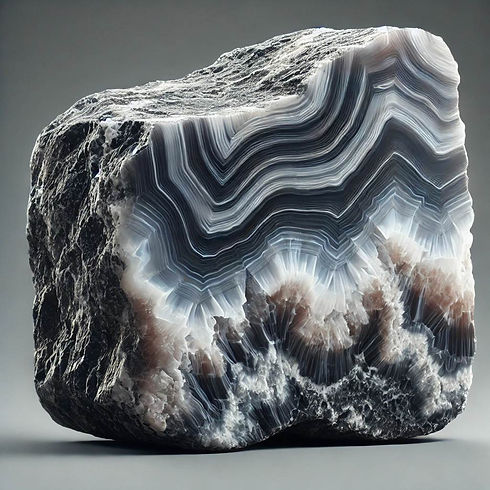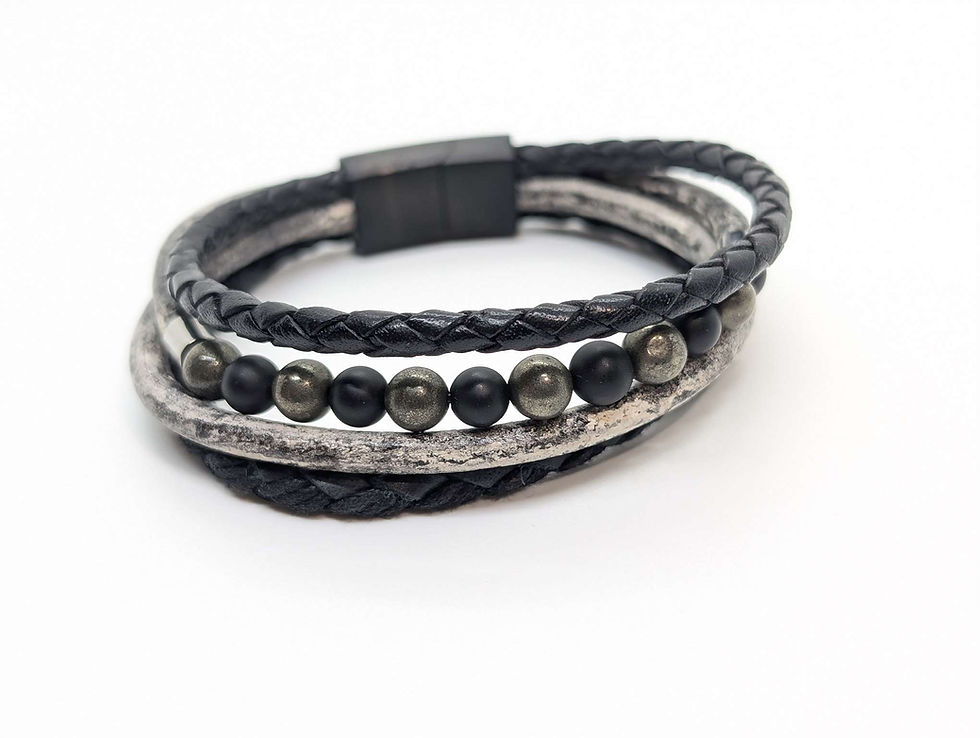

Onyx
Onyx, from the Greek "onyx", meaning "claw" , with its contrasting black and white veins , is a stone that inspires strength and mystery . Used since ancient times for its protective and stabilizing properties, it continues to fascinate with its beauty and energetic virtues .

Mineralogy of Onyx
Onyx is a variety of chalcedony , belonging to the large family of microcrystalline quartz .
Mineralogical characteristics:
Fibrous origin: Onyx is formed from microscopic layers of quartz fibers. These fibers align parallel to each other, creating the characteristic bands of onyx .
Chemical composition: Silicon dioxide (SiO2) with inclusions of iron and manganese oxides.
Hardness: 6.5 to 7 on the Mohs scale. Onyx is therefore relatively scratch-resistant, but can be damaged by impacts.
Density: 2.6 to 2.7 g/cm³.
Crystal system: Rhombohedral.
Color: Mainly black with white stripes, but can also have other colors such as brown, red or gray.
Luster: Vitreous to waxy.
Formation and deposits
Onyx is formed in the heart of fascinating geological processes:
Volcanic genesis: Onyx generally forms in cavities in volcanic rocks, such as amygdalae (solidified gas bubbles) or fractures.
Layered deposition: Silica-rich solutions, carried by water, seep into these cavities. Over time, the silica is deposited in successive layers, creating the characteristic parallel bands of onyx .
Influence of impurities: The presence of iron and manganese oxides in these solutions is responsible for the black or brown color of the bands. Variations in the composition of these solutions explain the alternation of light and dark bands.
Onyx Deposits Around the World
Onyx is a relatively common stone , found in many parts of the world. Some of the main deposits include:
Brazil: Brazil is renowned for the quality of its onyx, particularly in the states of Rio Grande do Sul and Minas Gerais.
India: India is a major producer of onyx , with significant deposits in the Deccan and Himalayas.
Madagascar : Madagascar is an important source of black onyx and multicolored onyx.
Uruguay: Uruguay is known for its honey-colored onyx and finely banded onyx .
United States: Onyx deposits are present in several US states, including Arizona, California, and Oregon.
Varieties of Onyx
There are several varieties of onyx , differing in their colors and patterns:
Black Onyx: Black onyx is the best-known variety, characterized by its intense and uniform black color.
Onyx sardonyx: Sardonyx has brown and white, even reddish, bands.
Banded Onyx: This variety features bands of different colors, creating unique patterns.
Eyed Onyx: Eyed onyx is distinguished by concentric circles around a central point.


Onyx Stone the story of Virtues: Strength, Protection and Anchoring
L'onyx, avec ses nuances obscures et énigmatiques, a envoûté l'esprit humain depuis la nuit des temps. La diversité de ses usages au fil des siècles atteste de son attrait immémorial.
-
Préhistoire: Des preuves archéologiques montrent que l'onyx était déjà utilisé au Paléolithique pour la fabrication d'outils et d'ornements.
-
Égypte ancienne: L'onyx était sculpté pour créer des amulettes, des scarabées sacrés et des vases canopes destinés à contenir les organes des défunts lors de la momification. Il était associé à la protection et à la renaissance dans l'au-delà. Les pharaons portaient des bijoux en onyx pour affirmer leur autorité et se protéger des forces du mal. On retrouve notamment de l'onyx dans le tombeau de Toutankhamon.
-
Civilisations précolombiennes: Les Aztèques et les Mayas utilisaient l'onyx pour la fabrication de masques, de bijoux et d'objets rituels. Ils l'associaient au dieu Tezcatlipoca, divinité de la nuit et de la sorcellerie.
-
Grèce antique: L'onyx était associé à Nyx, la déesse primordiale de la nuit. On lui attribuait le pouvoir de chasser les mauvais esprits et d'apporter la paix intérieure. Il était utilisé pour la fabrication de bijoux, de camées et d'intailles. Sa couleur noire contrastée se prêtait particulièrement bien à la sculpture de portraits et de scènes mythologiques.
-
Dans la Rome Antique : Les Romains appréciaient l'onyx pour sa dureté et sa résistance. Ils l'utilisaient pour confectionner des sceaux officiels et des intailles, gravées avec des motifs symboliques ou des portraits. L'onyx était considéré comme une pierre de protection contre les ennemis et les dangers. On pensait également qu'il pouvait aider à surmonter le chagrin et la tristesse. Pline l'Ancien mentionne l'onyx dans son Histoire Naturelle, décrivant ses différentes variétés et ses utilisations.
-
Au Moyen-Âge : L'onyx était à la fois apprécié pour sa beauté et craint pour ses supposés pouvoirs négatifs. Certains le considéraient comme une source de discorde et de malheur, tandis que d'autres le portaient comme talisman protecteur. Il était parfois utilisé pour la décoration des églises et des palais, notamment pour les sols, les colonnes et les autels.
-
Dans les Cultures Orientales : En Inde et en Chine, l'onyx est traditionnellement associé à la chance, à la prospérité et à la protection contre le mauvais œil. Dans la médecine ayurvédique, l'onyx est utilisé pour équilibrer les énergies du corps et favoriser la guérison.
-
L'Onyx Aujourd'hui : L'onyx reste une pierre populaire en bijouterie et en décoration. Son élégance sobre et intemporelle en fait un choix apprécié pour les créations contemporaines. Il est utilisé en lithothérapie pour ses vertus protectrices, stabilisatrices et énergisantes.
Onyx : Benefits and virtues for the body and mind
Chakra: root
Cognitive and mental improvement
Protection against negative energies: Onyx acts as an energetic shield , protecting against harmful influences and psychic attacks. It purifies the aura and strengthens the energy field.
Promotes introspection: Onyx encourages self-knowledge and awareness of one's own thought and behavior patterns. It helps identify one's strengths and weaknesses to better evolve on one's life path.
Helps to achieve goals: Onyx strengthens determination , perseverance and concentration . It helps to focus on one's goals and overcome obstacles that arise.
Emotional balance and well-being
Brings stability and grounding: Onyx is a grounding stone that promotes emotional balance and serenity . It helps overcome periods of stress, anxiety, and emotional upheaval.
Strengthens self-confidence: Onyx helps develop self-esteem, courage, and confidence in one's own abilities. It encourages one to take initiative and assert one's personality.
Helps manage emotions: Onyx helps you better manage your emotions , including anger , fear and sadness . It brings calm and serenity, promoting self-control.
Physical support and vitality
Strengthens bone structure: Onyx contributes to bone strength and can be helpful in cases of fractures or osteoporosis . It also promotes healing and tissue regeneration.
Improves Hearing: Onyx is known to relieve hearing disorders such as tinnitus, ear infections, and hearing loss. It improves sound perception and enhances hearing acuity .
Boosts the immune system: Onyx strengthens the body's natural defenses and helps fight infections . It stimulates the production of white blood cells and improves resistance to disease.
Tips for using tiger's eye
To preserve the energy of your onyx , it is important to purify and recharge it regularly:
Purification: Pass your onyx under clear water or purify it with sage smoke.
Recharging: Expose your onyx to sunlight or moonlight for a few hours.
Note: Lithotherapy is a complementary practice and in no way replaces medical advice.












































